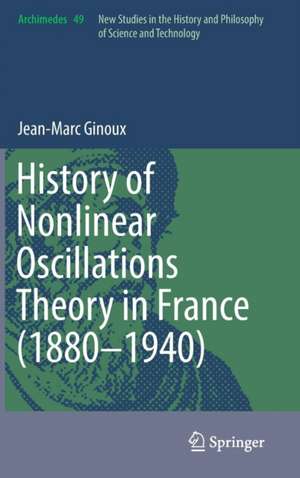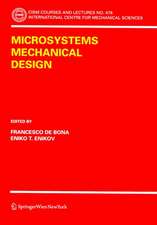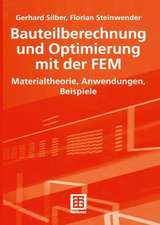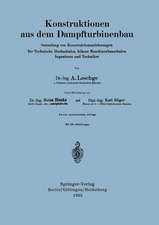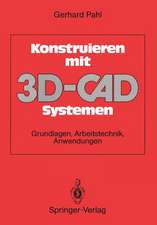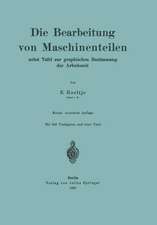History of Nonlinear Oscillations Theory in France (1880-1940): Archimedes, cartea 49
Autor Jean-Marc Ginouxen Limba Engleză Hardback – 26 apr 2017
This book reveals the French scientific contribution to the mathematical theory of nonlinear oscillations and its development. The work offers a critical examination of sources with a focus on the twentieth century, especially the period between the wars.
Readers will see that, contrary to what is often written, France's role has been significant. Important contributions were made through both the work of French scholars from within diverse disciplines (mathematicians, physicists, engineers), and through the geographical crossroads that France provided to scientific communication at the time.
This study includes an examination of the period before the First World War which is vital to understanding the work of the later period. By examining literature sources such as periodicals on the topic of electricity from that era, the author has unearthed a very important text by Henri Poincaré, dating from 1908. In this work Poincaré applied the concept of limit cycle (which he had introduced in 1882 through his own works) to study the stability of the oscillations of a device for radio engineering. The “discovery” of this text means that the classical perspective of the historiography of this mathematical theory must be modified. Credit was hitherto attributed to the Russian mathematician Andronov, from correspondence dating to 1929. In the newly discovered Poincaré text there appears to be a strong interaction between science and technology or, more precisely, between mathematical analysis and radio engineering. This feature is one of the main components of the process of developing the theory of nonlinear oscillations. Indeed it is a feature of many of the texts referred to in these chapters, as they trace the significant developments to which France contributed.
Scholars in the fields of the history of mathematics and the history of science, and anyone with an interest in the philosophical underpinnings of science will find this a particularly engaging account of scientific discovery and scholarly communication from an era full of exciting developments.
| Toate formatele și edițiile | Preț | Express |
|---|---|---|
| Paperback (1) | 1113.89 lei 6-8 săpt. | |
| Springer International Publishing – 9 mai 2018 | 1113.89 lei 6-8 săpt. | |
| Hardback (1) | 1119.87 lei 6-8 săpt. | |
| Springer International Publishing – 26 apr 2017 | 1119.87 lei 6-8 săpt. |
Din seria Archimedes
- 5%
 Preț: 909.01 lei
Preț: 909.01 lei - 18%
 Preț: 899.21 lei
Preț: 899.21 lei - 18%
 Preț: 785.55 lei
Preț: 785.55 lei -
 Preț: 382.36 lei
Preț: 382.36 lei - 18%
 Preț: 1833.33 lei
Preț: 1833.33 lei - 15%
 Preț: 643.84 lei
Preț: 643.84 lei - 18%
 Preț: 951.77 lei
Preț: 951.77 lei - 15%
 Preț: 645.79 lei
Preț: 645.79 lei - 15%
 Preț: 644.30 lei
Preț: 644.30 lei - 20%
 Preț: 577.19 lei
Preț: 577.19 lei - 18%
 Preț: 1048.19 lei
Preț: 1048.19 lei - 15%
 Preț: 646.62 lei
Preț: 646.62 lei - 18%
 Preț: 1110.09 lei
Preț: 1110.09 lei - 18%
 Preț: 1211.25 lei
Preț: 1211.25 lei - 18%
 Preț: 730.02 lei
Preț: 730.02 lei - 18%
 Preț: 1546.82 lei
Preț: 1546.82 lei - 18%
 Preț: 891.48 lei
Preț: 891.48 lei - 18%
 Preț: 776.88 lei
Preț: 776.88 lei - 18%
 Preț: 1214.60 lei
Preț: 1214.60 lei - 18%
 Preț: 1113.26 lei
Preț: 1113.26 lei - 18%
 Preț: 777.69 lei
Preț: 777.69 lei - 18%
 Preț: 995.83 lei
Preț: 995.83 lei - 15%
 Preț: 635.47 lei
Preț: 635.47 lei - 24%
 Preț: 1459.28 lei
Preț: 1459.28 lei - 18%
 Preț: 948.47 lei
Preț: 948.47 lei - 18%
 Preț: 1666.97 lei
Preț: 1666.97 lei - 18%
 Preț: 1114.83 lei
Preț: 1114.83 lei - 15%
 Preț: 645.60 lei
Preț: 645.60 lei
Preț: 1119.87 lei
Preț vechi: 1365.69 lei
-18% Nou
Puncte Express: 1680
Preț estimativ în valută:
214.32€ • 222.92$ • 176.93£
214.32€ • 222.92$ • 176.93£
Carte tipărită la comandă
Livrare economică 14-28 aprilie
Preluare comenzi: 021 569.72.76
Specificații
ISBN-13: 9783319552385
ISBN-10: 3319552384
Pagini: 381
Ilustrații: XXXVII, 381 p. 117 illus., 44 illus. in color.
Dimensiuni: 155 x 235 x 24 mm
Greutate: 0.76 kg
Ediția:1st ed. 2017
Editura: Springer International Publishing
Colecția Springer
Seria Archimedes
Locul publicării:Cham, Switzerland
ISBN-10: 3319552384
Pagini: 381
Ilustrații: XXXVII, 381 p. 117 illus., 44 illus. in color.
Dimensiuni: 155 x 235 x 24 mm
Greutate: 0.76 kg
Ediția:1st ed. 2017
Editura: Springer International Publishing
Colecția Springer
Seria Archimedes
Locul publicării:Cham, Switzerland
Cuprins
Part I. From sustained oscillations to relaxation oscillations.- Chapter 1. From the series-dynamo machine to the singing arc.- Chapter 2. The Great War and the first triode designs.- Chapter 3. Van der Pol’s prototype equation.- Part II. From relaxation oscillations to self-oscillations.- Chapter 4. Van der Pol’s lectures.- Chapter 5. Andronov’s notes.- Chapter 6. Response to Van der Pol’s and Andronov’s work in France.- Chapter 7. The first International Conference on Nonlinear processes: Paris 1933.- Chapter 8. The paradigm of relaxation oscillations in France.- Part III. From self-oscillations to quasi-periodic oscillations.- Chapter 9. The Poincaré-Lindstedt method.- Chapter 10. Van der Pol’s method.- Chapter 11. The Krylov-Bogolyubov method.- Chapter 12. The Mandelstam-Papeleksi School.- Chapter 13. From quasi-periodic functions to recurrent motions.- Chapter 14. Hadamard and his seminary.
Recenzii
“The text contains many interesting details describing experiments and mysterious devices used by researchers. The explanations are generously accompanied with diagrams and illustrations, the text contains numerous quotations and publication extracts. It is a good reading for anyone interested in mathematics and science, their history and philosophical underpinnings.” (Yuriy V. Rogovchenko, zbMATH 1485.34004, 2022)
Textul de pe ultima copertă
This book reveals the French scientific contribution to the mathematical theory of nonlinear oscillations and its development. The work offers a critical examination of sources with a focus on the twentieth century, especially the period between the wars.
Readers will see that, contrary to what is often written, France's role has been significant. Important contributions were made through both the work of French scholars from within diverse disciplines (mathematicians, physicists, engineers), and through the geographical crossroads that France provided to scientific communication at the time.
This study includes an examination of the period before the First World War which is vital to understanding the work of the later period. By examining literature sources such as periodicals on the topic of electricity from that era, the author has unearthed a very important text by Henri Poincaré, dating from 1908. In this work Poincaré applied the concept of limit cycle (which he had introduced in 1882 through his own works) to study the stability of the oscillations of a device for radio engineering. The “discovery” of this text means that the classical perspective of the historiography of this mathematical theory must be modified. Credit was hitherto attributed to the Russian mathematician Andronov, from correspondence dating to 1929. In the newly discovered Poincaré text there appears to be a strong interaction between science and technology or, more precisely, between mathematical analysis and radio engineering. This feature is one of the main components of the process of developing the theory of nonlinear oscillations. Indeed it is a feature of many of the texts referred to in these chapters, as they trace the significant developments to which France contributed.
Scholars in the fields of the history of mathematics and the history of science, and anyone with an interest in the philosophical underpinnings of science will find this a particularly engaging account of scientific discovery and scholarly communication from an era full of exciting developments.
Caracteristici
Offers the very first history of nonlinear oscillations Supports understanding of the approach to many mathematical problems of engineering Provides a thorough and clear documentation of this vital piece of the history of mathematical science Presents a vast iconography, an index and many useful references
